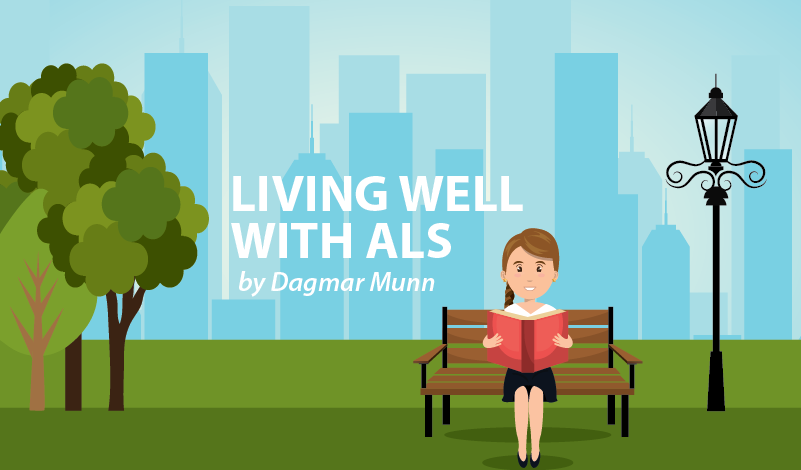3 Things You Can Do to Boost Your Energy and Well-being


I began to notice something new during my first year of living with ALS. Every day around mid-afternoon, my energy would drop. Sleepiness, lack of concentration and a case of the blahs would creep in. Was this a brand new symptom of ALS? No, luckily not. But the symptoms I experienced could be called a side-effect or consequence from having ALS.
Specifically, my early days living with ALS lacked what physical therapists refer to as “incidental activity.” This includes all the simple daily tasks that change our body position, stimulates our breathing and provides us with quick mental breaks. Activities such as: opening the curtains, watering the plants, checking the mailbox and taking out the trash.
Does this sound like something that you’ve experienced? If so, let me share what’s been working for me. These are three simple things that I practice to help boost my energy and balance my well-being.
Look out the window
Back in grade school I remember we’d get in trouble if, during class, the teacher caught us fidgeting or staring out the window. Turns out, our teachers should have had everyone take mandatory breaks just to gaze out the windows!
In her book, Healing Space; The Science of Place and Well-Being, Esther Sternberg, MD, writes about the specific response our brains have whenever we look at sweeping vistas: Mountains, a horizon, the ocean, forest, or anything that is nature. These particular views cause the hippocampal cortex area in our brain to release endorphins, a brain chemical that, in turn, reduces anxiety and enhances our feelings of focused calm.
If you spend long periods of time staring at a computer screen, try setting a timer and every 30-45 minutes stop whatever you are doing to look out a window. Take in the view, enjoy the colors you see, notice the beauty of nature and give your brain a mini-recess.
Just breathe – deeply!
Slumping and slouching while taking short, shallow breaths is a sure way to nod off to sleep. To increase alertness and fight fatigue we need more oxygen-rich blood reaching our brain. Part of the problem can be blamed on our sitting posture. If you are a “sloucher,” re-adjust to sit tall. Lift your rib cage up off your abdomen and take a few deeper, longer breaths; having both your low belly and chest moving with each breath.
There are many good descriptions of deep diaphragmatic breathing available via the Internet and on Youtube. For a simple version I like using this one taught by Jocelyn Olivier, CMT and creator of Neuromuscular Reprogramming.
In the video, Jocelyn Olivier gives the following instructions during her diaphragmatic breathing exercise “Count to 2 on the in-breath, and then 2 on the out-breath. Do this until your breathing evens out and becomes comfortable. Then, count to 3 on the in-breath, and 3 on the out-breath. Continue until it is comfortable. Finally, increase to a count of 4 on the in-breath, and 4 on the out-breath. Continue for about 10-20 breaths.”
When you return to the computer, try to maintain your good posture and improved breathing sequence.
Whatever moves – move it!
The big challenge for those of us living with ALS is that our weak muscles cause us to move less, which in turn causes more muscles to become weak. Combine that with lack of movement for our healthy non-ALS affected muscles and we end up with “disuse atrophy.”
It doesn’t matter whether we are doing the moving or someone helps us do it, our bodies benefit from movement breaks. Digestion is enhanced, joints are lubricated and lymph moves toxins out of circulation. And, guess what? When our muscles move, they cause our brain to release endorphins! The same feel-good brain chemicals released when looking out a window and from deep diaphragmatic breathing.
Need some ideas to get moving? Try these:
If you’re sitting, stand up. If you can’t stand, stay sitting, but stretch, lean and twist. Extend your legs and flutter kick up and down. Lift your shoulders, lift your arms and make circles in all directions. Turn your head right, left, chin up, then down. Smile big, purse your lips and smile big.
Throughout the past seven years that I have been living with ALS, I’ve made it a regular habit to take several well-being breaks such as these several times a day. I’m happy to report I feel alert, re-energized and ready to tackle the rest of my day.
***
Note: ALS News Today is strictly a news and information website about the disease. It does not provide medical advice, diagnosis, or treatment. This content is not intended to be a substitute for professional medical advice, diagnosis, or treatment. Always seek the advice of your physician or other qualified health provider with any questions you may have regarding a medical condition. Never disregard professional medical advice or delay in seeking it because of something you have read on this website. The opinions expressed in this column are not those of ALS News Today, or its parent company, Bionews Services, and are intended to spark discussion about issues pertaining to ALS.







klaus
Dagmar offers good advice; taking deep-breathing breaks regularly through the day keeps me sharper.
Just finishing my 2nd year of a typical ALS course. Its psychologically helpful to me to track my progress with a (free) monthly FRS score (*go to patientslikeme.com to find the quiz, and lots of other support). My FRS is 30 today. Am very comfortable lounging all day in a very agile Permobil wheel-chair, blogging, and cruising the world on a computer now. Believe it that 10 years ago I was roller-blading long-distance across a dozen European countries!
Another huge benefit, I've been able to acquire (a donation!), to maximize my current physical independence, is to install a 4-way overhead ceiling lift system; it carries me from my bed, to the shower, to the toilet, and the TV, with very minimal assistance from my sweetheart. In my case it was a re-cycled Sure-Hands lift system (1/4 of the expensive new cost!). It takes time to find one on-line, but it's worth every penny! Stay in touch with your local ALS/MS storage locker room and offices; they were very helpful for me to get this good technology. Staying proactive keeps me cheered up and motivated. Monthly community support meetings help too. Klaus in beautiful Puget Sound, WA.